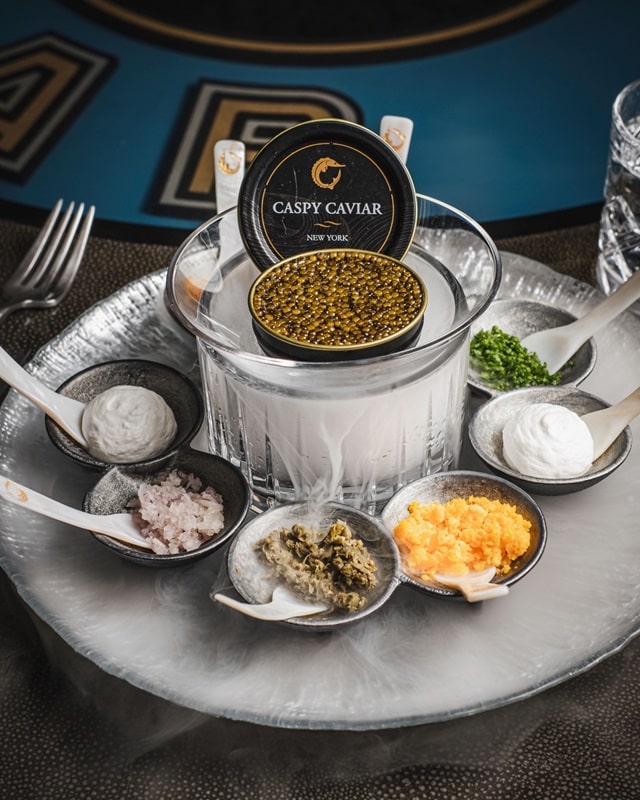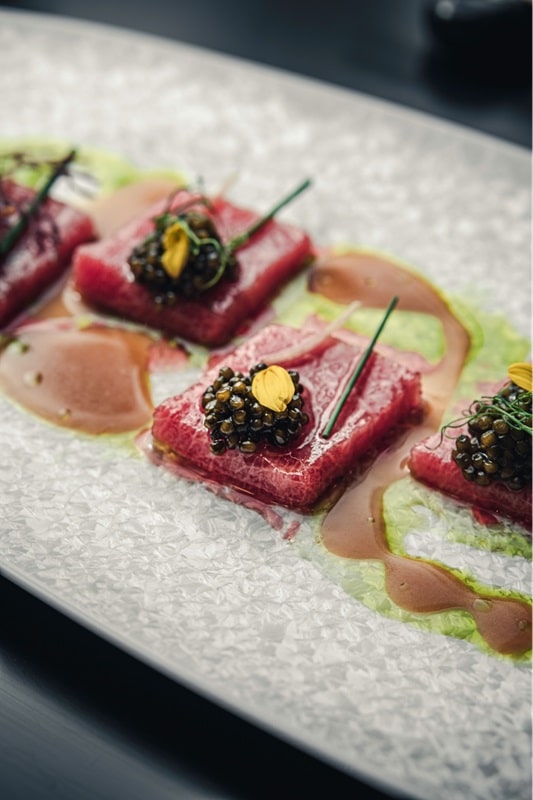Seafood 101:
The Different Types of Caviar
Caviar, the epitome of luxury and indulgence, has been celebrated as a delicacy throughout history. Renowned for its exquisite taste and unique texture, caviar holds a special place in world cuisine. But did you know that not all caviar is the same?
Whether you are an aspiring epicurean or a foodie curious about gastronomic delights, this comprehensive exploration of the different types of caviar will awaken your taste buds and deepen your appreciation for the richness and diversity of seafood from around the world.
What type of fish does caviar come from?
Caviar traditionally comes from sturgeon, a prehistoric and majestic fish that has been swimming in the world’s rivers and oceans for millions of years. Sturgeon caviar is renowned for its exceptional quality and is considered the most prized and sought-after type of caviar. Each variety offers its own unique flavor profile and characteristics, adding to the diverse range of options available to connoisseurs.

Enjoy caviar, seafood, and more on the Vegas Strip. Book your reservation today.
Are there different caviar fish types?
Yes, there are different caviar fish types. While sturgeon is the most well-known and widely celebrated fish for caviar production, other species contribute to this delectable delicacy. Some examples include:
- Beluga: Known for its large size and distinct buttery flavor, Beluga caviar comes from the Beluga sturgeon native to the Caspian Sea
- Osetra: Osetra caviar originates from the Osetra sturgeon and typically showcases a range of shades from golden to deep brown with a nutty and creamy taste
- Sevruga: Caviar sourced from the sevruga sturgeon tends to have smaller-sized eggs, a grayish color, and an intense flavor profile often described as briny or salty
- Kaluga: Also referred to as Amur River Beluga due to its similar characteristics, Kaluga caviar comes from Kaluga sturgeons found in China’s rivers and offers larger grains with rich flavors reminiscent of traditional Belugas
These are just a few examples of fish that provide unique variations of caviar, each prized for its own distinctive qualities cherished by gourmet enthusiasts.
How many types of caviar are there?
Several types of caviar are available, each offering distinct flavors, textures, and appearances. While the exact number may vary depending on classification and regional variations, some common types of caviar include:
- Beluga caviar
- Osetra caviar
- Sevruga caviar
- Kaluga (Amur River Beluga) caviar
- Sterlet caviar
- Paddlefish caviar
- Hackleback (Shovelnose) Sturgeon caviar
- Bowfin caviar
Additionally, there are specialty or infused caviars where herbs, spices, or other flavors are added to enhance the taste experience. Overall, these various types of caviar cater to a wide range of preferences and offer an array of exquisite options for seafood aficionados.
How many caviar varieties are there?
Some commonly recognized caviar varieties include:
- Caspian caviar: This refers collectively to the caviar originating from the Caspian Sea region, including Beluga, Osetra, and Sevruga
- Iranian caviar: Iran produces a range of high-quality caviars such as Beluga, Osetra, and Karaburun
- Russian caviar: Russia is renowned for producing various caviar types like Ossetra, Sevruga, and Sterlet
- American caviar: The United States offers unique caviars sourced from paddlefish (sometimes referred to as “American sturgeon”), hackleback (shovelnose) sturgeon, and bowfin fish eggs called “Cajun caviar,” among others
- Chinese caviar: China has gained recognition in recent years for producing top-quality Kaluga or Amur River Beluga caviar along with other species like Siberian sturgeon or Schrenkii Esox (Snakehead) fish eggs known as “Chinese sevruga”
What is the difference between classic, gold, and special reserve caviar?
The terms “classic,” “gold,” and “special reserve” are often used to denote different grades or qualities of caviar, each representing distinct characteristics and pricing levels. However, it is important to note that the specific meanings can vary depending on the producer or brand.
- Classic caviar: “Classic” typically refers to a standard or baseline grade of caviar, representing a good quality product sourced from sturgeon eggs with consistent taste, texture, and appearance
- Gold caviar: “Gold” is often associated with premium or luxury-grade caviar. It usually signifies exceptional quality meticulously selected and characterized by large-sized eggs, exquisite flavor profiles, buttery textures, and overall desirability.
- Special reserve caviar: “Special reserve” implies rarity and exclusivity, such as the caviar has undergone additional aging or maturation processes to enhance its flavor complexity and depth. Caviar labeled “special reserve” could be sourced from particularly rare sturgeon species or aged for an extended period to develop unique flavors and textures. It is often released as a limited edition offering.
What is the best type of caviar?
Determining the best type of caviar is subjective and depends on individual preferences. Each variety of caviar offers its own unique taste, texture, and characteristics, making it challenging to declare one as the absolute best.
Some people might prefer the delicate creaminess of Osetra caviar or appreciate Beluga caviar’s rich buttery flavor. Others may find Sevruga’s intensely briny taste more appealing. Ultimately, it comes down to personal taste preferences and experiences.
Are sturgeon roe and caviar the same?
Sturgeons are known for producing high-quality and highly sought-after roe, which is often referred to as caviar. The term “caviar” specifically refers to the salted eggs of sturgeon fish. However, it’s important to note that not all fish eggs can be labeled as caviar. Only the eggs from certain sturgeon species are recognized as true caviar.
These sturgeon eggs undergo a delicate salting process to enhance their flavor and preserve them for consumption. While some people may use the word “roe” more broadly to refer to any fish egg, when discussing luxury delicacies like caviar, it implies the exquisite roe from sturgeon species.
What are the unique characteristics, flavors, and culinary applications of caviar?
Caviar possesses a range of unique characteristics, flavors, and culinary applications that make it a highly prized and coveted delicacy. Here are some key aspects:
- Size and texture: Caviar eggs can vary in size from small to large, with each type having its own distinct texture. They can be smooth, firm, or even slightly pop when bitten, providing a delightful sensation on the palate.
- Flavor profiles: Different types of caviar offer diverse flavor profiles that range from buttery and nutty to briny and salty. Some varieties may have earthy undertones or hints of seaweed, while others exhibit more subtle flavors with creamy notes.
- Complexity: Fine caviar often offers multidimensional flavors that evolve as they coat the taste buds. This complexity adds depth and intrigue to the overall culinary experience.
- Versatility: Caviar is incredibly versatile when it comes to culinary applications. It is commonly enjoyed as a garnish or topping for various dishes such as blini (small pancakes), sushi rolls, canapés, omelets, pasta dishes, or served on its own with crackers or toast.
- Luxury appeal: The rarity and exclusivity associated with caviar contribute to its luxurious image in gastronomy circles worldwide. It is often featured prominently in high-end restaurants or during special occasions or celebrations as an exquisite treat.
Enjoy different types of caviar on the Vegas Strip

Indulge in different kinds of caviar at Aqua Seafood & Caviar Restaurant on the iconic Vegas Strip. Join us for an unforgettable dining experience where you can savor and explore a variety of exquisite caviars from around the globe. From the rich Kaluga to the tantalizing Osetra, our expertly curated menu promises an extraordinary seafood culinary journey. Elevate your taste buds and indulge in pure luxury with each precious bite.
Come join us for dinner today and embark on a caviar adventure.
Sources:
Bernstein, N. (2023). A Beginner’s Guide to Caviar.
14 Next-Level Caviar Recipes. (2020).
What Is Caviar? Lear All About Caviar, Where It Comes From, and How to Serve It. (2021).
